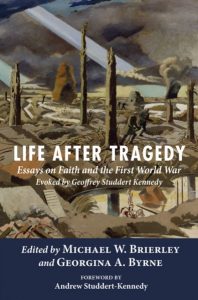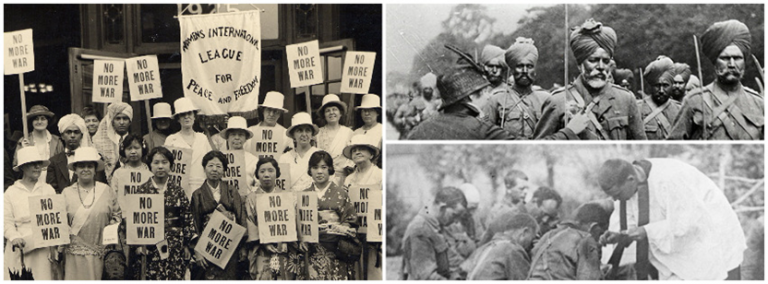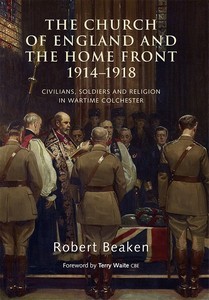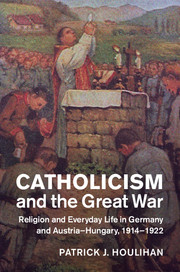Contemporary Church History Quarterly
Volume 25, Number 3 (September 2019)
Review of Anita Rasi May, Patriot Priests: French Catholic Clergy and National Identity in World War I (Norman, OK: University of Oklahoma Press, 2018), X + 162 Pp., ISBN: 9780806159089.
By Heath Spencer, Seattle University
More than 33,000 French priests and members of religious orders served in the First World War. Although many of them were government-appointed or volunteer chaplains, the majority were involved in other ways—as stretcher-bearers, nurses, and combatants. Anita Rasi May draws on the memoirs, letters and biographies of thirty-three of these individuals in order to shed light on their subjective experiences. She begins with a survey of anticlerical policies during the prewar Third Republic, a “culture war” situation in which the French Catholic Church saw its status and privileges significantly curtailed. She follows up with analysis of the responses of French priests to the outbreak of war, the variety of ways in which they participated, and their perceptions of the war’s meaning for France and the church. As she assesses the consequences of the war on church-state relations, she concludes that “in the postwar period there emerged a new relationship between the priests and the people due in large part to the memory of the priests’ wartime service and to their key role in memorializing their many fallen comrades. This newly won respect provided the atmosphere in which both the government and church leaders worked out compromises in their ongoing relationship” (10).
 The anticlerical policies of the prewar era provide an important backdrop for understanding the mentalities and motivations of French priests, bishops and members of religious orders during the war itself. From the 1870s forward, French political leaders feared that Catholic clergy and institutions “did not form patriots but rather encouraged loyalty to monarchical government and to an international organization, the Catholic Church, based in Rome” (16). They responded by dissolving the Jesuits and other religious orders, abolishing the military chaplaincy, and ending priests’ exemption from military service. The Catholic Church’s dubious role in the Dreyfus Affair provided the pretext for further anticlerical measures, including the abolition of church schools and the formal separation of church and state. The government’s open hostility to the Catholic Church was accompanied by a long, steady decline in religious observance, especially among people of the working class, and among men of all classes.
The anticlerical policies of the prewar era provide an important backdrop for understanding the mentalities and motivations of French priests, bishops and members of religious orders during the war itself. From the 1870s forward, French political leaders feared that Catholic clergy and institutions “did not form patriots but rather encouraged loyalty to monarchical government and to an international organization, the Catholic Church, based in Rome” (16). They responded by dissolving the Jesuits and other religious orders, abolishing the military chaplaincy, and ending priests’ exemption from military service. The Catholic Church’s dubious role in the Dreyfus Affair provided the pretext for further anticlerical measures, including the abolition of church schools and the formal separation of church and state. The government’s open hostility to the Catholic Church was accompanied by a long, steady decline in religious observance, especially among people of the working class, and among men of all classes.
In light of such troubling developments, French clergy saw the Great War as an opportunity to demonstrate their patriotism and prove their worth to national community. Like their counterparts in other belligerent countries, French priests believed their nation’s cause was just, but an equally powerful motivation for supporting the war was the prospect of restoring the Catholic Church to its former prominence and reversing the secularization of state and society. May cites the example of a Franciscan seminarian who believed that the war would lead to a rebirth of “the France of years past, that is to say, the true Christian France” (50). As ordinary people flocked to religious ceremonies and cheered for priests who volunteered for war service, many clergy believed they were witnessing a revitalization of religious life and an end to anticlerical hostility. These hopes and expectations help explain why so many priests volunteered for combat and non-combat roles, why French bishops gave their assent, and why so few French clergy opposed the war and the phenomenon of the soldier priest.
May’s research gives us a glimpse into the inner world of those clergy who spent time at the front. For example, Jesuit Pierre Teilhard de Chardin, who went on to become one of the twentieth century’s most prominent philosophers, was a stretcher-bearer with the 8th Regiment of Moroccan Riflemen. He saw the war as a “baptism into reality” (52) and hoped his position would give him influence among the men with whom he served. A Franciscan chaplain named Édouard de Massat described the war itself as “a missionary whose voice is more eloquent than our own” and expressed the hope that France would emerge from the struggle “with a new soul” (56). As time went on, priests grew more realistic about the prospects of mass conversion and religious renewal, and their efforts at evangelizing gave way to an emphasis on pastoral care and service to their comrades in arms. This was as true of soldier priests and medical personnel as it was of chaplains.
May notes that most priests adjusted well to military life and found it easy to combine patriotic fervor and military service with their Catholic faith. This was also true of those who experienced combat. May provides numerous examples of priests who were promoted to officer status, led assaults on enemy positions, and participated actively and sometimes enthusiastically in killing. Although none of May’s thirty-three priests were pacifists, all were aware of the horrors of war (especially the damage it inflicted on their own countrymen) and occasionally struggled over the ethics of killing. Although May asserts that “in these memoirs, journals, autobiographies and biographies…there is no love of war for itself” (78), she also quotes a chaplain named Jean Lagardère who said of the front: “I am happy here: the friendship of the men, the rattling of arms, the noise of the cannon, the whistling of bullets, the view of the trenches, their infected mud delights me, thrills me, makes me quiver. I am only at home there, I only breathe there, I only do good there. I only feel myself a man there” (78). They knew the horrors of war, and some loved it anyway.
Priests’ reactions to the war were complicated and contradictory on a variety of levels. For example, they expressed contempt for men who refused to fight or mutilated themselves to avoid military service, yet some of them intervened on behalf of soldiers condemned to death for breaches of discipline. Some regretted killing the enemy, or regretted enjoying it, but few gave much thought to the humanity of the enemy. Most preferred to focus on the French soldier’s self-sacrifice rather than his role as a perpetrator of violence, and they made frequent comparisons with Christ’s sacrifice on the cross. A war sermon by chaplain Louis Lenoir was one of the more eloquent and revealing expressions of this blend of faith, war, and nationalist euphoria: “Like that of Christ, this ‘beautiful blood of France’ was today, as it has always been in history, ‘liberating blood’…spread across Europe and to the extremities of the earth to defend nations against injustice and support religious and social freedom…search all the corners of the world where violated liberty has called for help, everywhere you will find traces of French blood” (85).
Whether they were chaplains, medical personnel, or soldiers, French priests took their apostolic work seriously. They administered the sacraments, counseled individual soldiers, mailed or hand delivered letters, procured books and personal items, established social spaces where soldiers could relax, visited soldiers’ families when on leave, and conveyed gifts from those families to soldiers with whom they served at the front. They heard confessions, granted absolution, and gave communion before attacks, and in the aftermath, they performed last rites for the dying, presided over burials and masses for the dead, and helped with the mapping of cemeteries. Not surprisingly, the pastoral ministry of priests at the front seems to have been the role that was most widely appreciated and accepted, even among persons who had left the church and had no interest in returning.
In terms of long-term impact, the priests’ expectations only partly coincided with reality. When the war began, many of them believed they would have the opportunity “to evangelize men who were not the usual churchgoers in early twentieth-century France” (64). They also hoped to demonstrate that they were just as manly and patriotic—and as much a part of the national community—as other French men. Although the mass conversions did not occur, priests did develop “bonds of brotherhood” with many soldiers, “based more on mutual respect than on shared faith. They also found in themselves a capacity for violence and for being swept up into the exaltation of battle, which strengthened their feelings of brotherhood and empathy for their fellows” (109). As an institution, the French Catholic Church enjoyed a slight improvement of its status in the postwar era. The state and the education system remained secularized, but members of religious orders who had returned from exile to fight for France were allowed to remain there when the war had ended. The French government also restored diplomatic relations with the Vatican, and though anticlerical laws remained on the books, they were not always rigorously enforced. In fact, when the government of Édouard Herriot attempted to do so in 1926, veteran priests played an important role in the protests that forced the state to back down. May credits these successes to the fact that priests enjoyed a new level of respect and status due to their wartime service.
May’s book offers a fascinating glimpse into the fears, frustrations and hopes of Catholic clergy during the First World War. The priests themselves are a stark example of the “self-mobilization” that was so prevalent in the “war cultures” of Europe during this period.[1] At the same time, the book suffers from a number of shortcomings in terms of framing as well as the selection and interpretation of sources.
First, it relies too much on priests’ own perceptions of their impact without considering other kinds of data. For example, it would be helpful to see information on baptisms, confirmations and other indicators of religious observance before, during and after the war. To what extent did the war service of priests and the rapprochement between church and state disrupt or mitigate the long, steady decline in public, corporate worship? May also refers to wartime rumors and disinformation in “anticlerical newspapers and speeches” (116) but does not comment on the intensity of anticlerical discourses at different points in time. Tracking changes and continuities in the anticlerical press would be another way of assessing whether the priests’ war service had an impact on popular opinion (i.e. whether they achieved the respect and recognition they longed for or merely imagined it).
A second shortcoming is the fact that May engages the question of clerical violence on only the most superficial level. She notes that soldier priests killed and sometimes expressed regret for killing (or for enjoying it) and follows up with the claim that these experiences made it easier for priests to identify with and minister to other men who had been in combat. May does not explore the long tradition of Catholic theological reflection on violence, nor does she acknowledge that there were many other possible areas of shared experience (visiting brothels, for example) from which priests were expected to abstain. What made military violence different?
May’s temporal framework is also problematic. Her story ends in 1926 at what appears to be a comeback moment for Catholics in France’s culture wars—a happy ending of sorts. Extending the study to 1940 or 1945 would complicate things, as May would have to grapple with those segments of the Catholic Church that supported far right movements, cast their lot with the Vichy regime and celebrated the demise of the Third Republic.
Finally, May’s study adopts an exclusively national perspective with only the briefest references to other European states and the wider world. Comparative analysis across European cultural and religious landscapes would make it more difficult to affirm the validity of bargains in which clergy supported questionable regimes and policies in exchange for acceptance and influence. The response of many German clergy to their country’s “national renewal” in 1933 should serve as a cautionary tale. Likewise, May fails to incorporate insights from a large body of recent research on the global dimensions of the war. Though she notes the existence of colonial troops, she offers no meaningful discussion of their religious and cultural identities or their wartime experiences. Several of May’s priests (including Teilhard and Lenoir) embraced their role as missionaries and affirmed France’s “civilizing mission” throughout the world, but May does not indicate the context in which those efforts and assumptions played out. For example, the majority of France’s colonial soldiers were forcibly recruited through processes that did great violence to them, their families, and their communities. After arriving in Europe, they were deployed as shock troops in an effort to lower the death toll among white French soldiers.[2] We cannot understand the ideas and actions of priests like Teilhard and Lenoir apart from these realities. By neglecting them, May’s book remains confined to the same limited horizons as the priests’ own accounts of the war and its meaning.
[1] See John Horne, “Public Opinion and Politics,” in A Companion to World War I, ed. John Horne (Hoboken, NJ: Wiley, 2004), 280-281.
[2] See Joe Lunn, Memoirs of the Maelstrom: A Senegalese Oral History of the First World War (Portsmouth, NH: Heinemann, 1999).

 Studdert Kennedy, or ‘Woodbine Willie’, as he was affectionately known by soldiers, has long been the most well-known of the British wartime chaplains. He has attracted the attention of scholars of various kinds for his poetry (The Unutterable Beauty, published in 1927, remains much admired in some quarters), his trenchant criticisms of the status quo, his uncompromising socialism, his pungent scepticism of authority (one of his books was simply called Lies), and his determination that the ghastliness of war must surely and eventually yield a better world. But he was also the embodiment of courage and unselfconscious sacrifice (he won the Military Cross) and his early death, exhausted, at the age of 45, presented something of the quality of a martyrdom—not so much to the powers of the age but perhaps to the whole age in which he lived. Westminster Abbey notoriously turned down the idea of hosting his funeral. One suspects that Studdert Kennedy would have been delighted by the compliment.
Studdert Kennedy, or ‘Woodbine Willie’, as he was affectionately known by soldiers, has long been the most well-known of the British wartime chaplains. He has attracted the attention of scholars of various kinds for his poetry (The Unutterable Beauty, published in 1927, remains much admired in some quarters), his trenchant criticisms of the status quo, his uncompromising socialism, his pungent scepticism of authority (one of his books was simply called Lies), and his determination that the ghastliness of war must surely and eventually yield a better world. But he was also the embodiment of courage and unselfconscious sacrifice (he won the Military Cross) and his early death, exhausted, at the age of 45, presented something of the quality of a martyrdom—not so much to the powers of the age but perhaps to the whole age in which he lived. Westminster Abbey notoriously turned down the idea of hosting his funeral. One suspects that Studdert Kennedy would have been delighted by the compliment. The extent and importance of religious faith in the First World War is undoubtedly one of the great rediscoveries of the centenary years. Among the belligerent empires and nations, religion proved to be a vital sustaining and motivating force, with the Ottoman war effort cloaked as a jihad, the United States entering the war on Good Friday 1917, and even professedly secular societies such as France experiencing a degree of religious revival. At the same time religious convictions also provided some of the most powerful critiques of the war, contributing to tireless peace-making efforts by Pope Benedict XV and to the stand of thousands of conscientious objectors in Great Britain and the United States. Faith also inspired many of the women who were active in war resistance and initiatives for peace, including Quakers, feminists and Christian socialists who were involved in the Hague Peace Congress of 1915, the resulting Women’s International League, and also grassroots action such as the Women’s Peace Crusade, which was launched in Glasgow in the summer of 1916.
The extent and importance of religious faith in the First World War is undoubtedly one of the great rediscoveries of the centenary years. Among the belligerent empires and nations, religion proved to be a vital sustaining and motivating force, with the Ottoman war effort cloaked as a jihad, the United States entering the war on Good Friday 1917, and even professedly secular societies such as France experiencing a degree of religious revival. At the same time religious convictions also provided some of the most powerful critiques of the war, contributing to tireless peace-making efforts by Pope Benedict XV and to the stand of thousands of conscientious objectors in Great Britain and the United States. Faith also inspired many of the women who were active in war resistance and initiatives for peace, including Quakers, feminists and Christian socialists who were involved in the Hague Peace Congress of 1915, the resulting Women’s International League, and also grassroots action such as the Women’s Peace Crusade, which was launched in Glasgow in the summer of 1916. Colchester’s social elite, which was well represented in the Church of England parishes, was conservative, nationalist and hierarchical. Its members supported the British government’s decision to go to war in August 1914 for moral as well as political reasons. They joined in the widespread campaign urging young men to join the armed forces, until conscription was introduced in 1916, rendering such appeals superfluous. Thereafter the leading men set an example by supporting campaigns for contributions to the War Savings Bonds, while the church ladies were very active in ministering to the troops training in Colchester and to the wounded. Church people were assiduous in providing hospitality to the troops, and at least thirty five social clubs were established where recreational facilities and food were supplied, often at little cost. In part such provision was seen as a Christian virtue, but, as Beaken notes, in part it was inspired by the desire to keep the soldiers out of public houses, and so to keep prostitution and its attendant problems at bay.
Colchester’s social elite, which was well represented in the Church of England parishes, was conservative, nationalist and hierarchical. Its members supported the British government’s decision to go to war in August 1914 for moral as well as political reasons. They joined in the widespread campaign urging young men to join the armed forces, until conscription was introduced in 1916, rendering such appeals superfluous. Thereafter the leading men set an example by supporting campaigns for contributions to the War Savings Bonds, while the church ladies were very active in ministering to the troops training in Colchester and to the wounded. Church people were assiduous in providing hospitality to the troops, and at least thirty five social clubs were established where recreational facilities and food were supplied, often at little cost. In part such provision was seen as a Christian virtue, but, as Beaken notes, in part it was inspired by the desire to keep the soldiers out of public houses, and so to keep prostitution and its attendant problems at bay. Houlihan’s argument is that conventional interpretations of religion in the First World War, which emphasize the secularizing effect of a shattering war experience as expressed in the voices of cultural modernists, do not capture the experiences of German and Austro-Hungarian Catholics. Rather, he asserts that Catholics adjusted to industrial warfare because their transnational faith and its practices helped them to cope relatively successfully with the upheaval and brutality of war—more successfully than Protestants, whose faith (in the case of Germany) was more closely tied to the defeated state.
Houlihan’s argument is that conventional interpretations of religion in the First World War, which emphasize the secularizing effect of a shattering war experience as expressed in the voices of cultural modernists, do not capture the experiences of German and Austro-Hungarian Catholics. Rather, he asserts that Catholics adjusted to industrial warfare because their transnational faith and its practices helped them to cope relatively successfully with the upheaval and brutality of war—more successfully than Protestants, whose faith (in the case of Germany) was more closely tied to the defeated state.